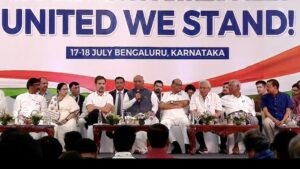Recently there is a lot of discussion about the name ‘India’. But have you ever wondered how India got its name? We all know the basic history of India, with Portuguese explorer Vasco da Gama being the first European to discover a sea route to India via the Atlantic Ocean. Being one of the oldest countries in the world, India has been known by various names before settling on its current one, including Hindostan, Aryavarta, Bharat, to name a few.
Also read:Editorial with Sujit Nair: Are we doing enough to heal Manipur?
Among the oldest names associated with the Indian subcontinent is “Meluha,” mentioned in ancient Mesopotamian texts to refer to the Indus Valley Civilization. “Bharat,” traced to Puranic literature and the Hindu epic Mahabharata, represents one of the earliest recorded names, denoting a supraregional and subcontinental territory often linked to the freedom struggle. Another significant name is “Aryavarta,” found in the Manusmriti, referring to the land occupied by the Indo-Aryans between the Himalayas and the Vindhya mountain ranges. Additionally, “Jambudvipa,” a name found in Vedic texts, describes the region as the “land of the Jamun trees,” still used in some Southeast Asian countries to depict the Indian subcontinent. “Nabhivarsa” is another name mentioned in Jain literature for the country before it became known as Bharat.
Initially, there was no specific word for “Indus” or “India.” The Aryans called the Indus River the “Sindhu River,” derived from a Sanskrit word. The name “India” is derived from the Indus Valley Civilization. The Indus River was initially called the “Sindu River,” and “Hindu” is the Persian equivalent of “Sindhu.” When the Persians invaded, they started calling the area “Hindu,” and the Persian suffix “-stan” was added, resulting in the name “Hindustan” or “land of the Hindus.”
Later, the Greeks called the land “Indos” due to a loss in the use of the ‘h’ dialect in the Greek language. Consequently, the people living in the Indus Basin were called “Indians.” Another name for India is “Bharat,” derived from an ancient tribe called Bharata.
During the British invasion, “Hindustan” was widely used in the 16th century, but British maps increasingly started using “India” in the late 18th century. During the drafting of the Indian Constitution, the name “Bharat” or “India” for the country was a matter of debate among delegates. Over the years, discussions and proposals have been made to officially change the country’s name to “Bharat,” but no final decision has been made.
So that was the history of how the name, ‘India’ came into being. But why is the name “India” trending today, according to news reports from Al Jazeera, last week, Prime Minister Narendra Modi’s political opponents formed a new alliance known as “INDIA.” The alliance aims to prevent Modi’s third consecutive victory and defeat his Bharatiya Janata Party (BJP) in the upcoming general elections scheduled for next year. INDIA stands for Indian National Developmental Inclusive Alliance and currently includes 26 opposition parties, with the possibility of more parties joining before the elections in May. The alliance is led by the Indian National Congress party, which has historically held significant influence in the country’s politics.

During a two-day conclave of the alliance in Bengaluru on July 18, Congress leader Rahul Gandhi emphasized that the election battle is between “Narendra Modi and INDIA,” symbolizing the clash of ideologies and the country’s future direction. Major opposition parties forming part of INDIA include the Trinamool Congress (TMC) governing West Bengal, the Dravida Munnetra Kazhagam (DMK) in power in Tamil Nadu, and the Aam Aadmi Party (AAP) ruling in Delhi and Punjab.
Other vital allies in the alliance include the Janata Dal-United (JD-U) and the Rashtriya Janata Dal (RJD), jointly governing Bihar, and the Jharkhand Mukti Morcha (JMM), leading the government in Jharkhand. Furthermore, various regional and national parties such as the National Congress Party (NCP-Sharad Pawar), the Shiv Sena (UBT), the Samajwadi Party (SP), the National Conference (NC), the People’s Democratic Party (PDP), and others are also part of this 26-party coalition.
The alliance aims to challenge the BJP on several fronts, focusing on issues such as the struggling economy, increasing unemployment, attacks on minorities, particularly Muslims, by Hindu nationalists, and the shrinking space for dissent and media freedom during Modi’s nearly decade-long rule. Additionally, the alliance seeks to address various other domestic challenges, including the ethnic conflict in the northeastern state of Manipur.
As an independent media platform, we do not take advertisements from governments and corporate houses. It is you, our readers, who have supported us on our journey to do honest and unbiased journalism. Please contribute, so that we can continue to do the same in future.
